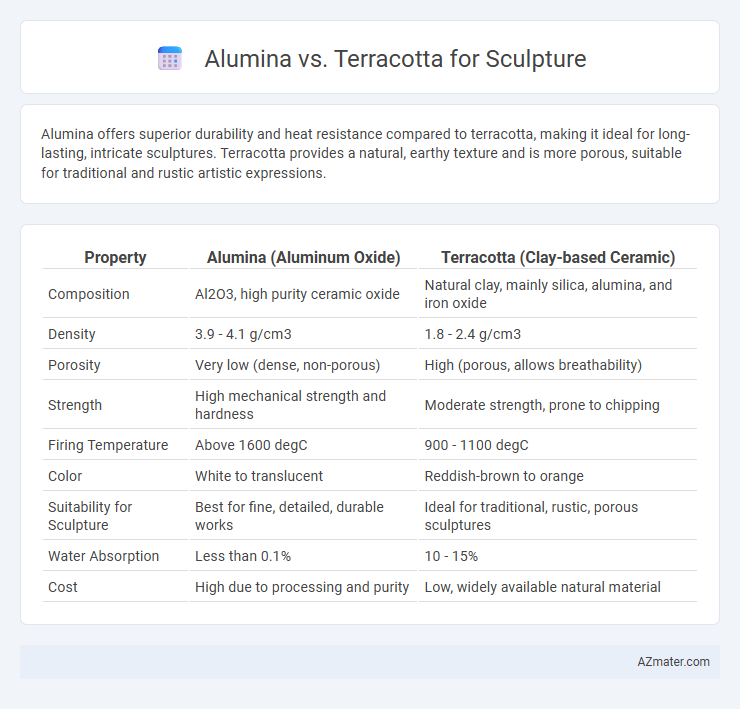Alumina offers superior durability and heat resistance compared to terracotta, making it ideal for long-lasting, intricate sculptures. Terracotta provides a natural, earthy texture and is more porous, suitable for traditional and rustic artistic expressions.
Table of Comparison
| Property | Alumina (Aluminum Oxide) | Terracotta (Clay-based Ceramic) |
|---|---|---|
| Composition | Al2O3, high purity ceramic oxide | Natural clay, mainly silica, alumina, and iron oxide |
| Density | 3.9 - 4.1 g/cm3 | 1.8 - 2.4 g/cm3 |
| Porosity | Very low (dense, non-porous) | High (porous, allows breathability) |
| Strength | High mechanical strength and hardness | Moderate strength, prone to chipping |
| Firing Temperature | Above 1600 degC | 900 - 1100 degC |
| Color | White to translucent | Reddish-brown to orange |
| Suitability for Sculpture | Best for fine, detailed, durable works | Ideal for traditional, rustic, porous sculptures |
| Water Absorption | Less than 0.1% | 10 - 15% |
| Cost | High due to processing and purity | Low, widely available natural material |
Introduction to Alumina and Terracotta in Sculpture
Alumina, a refined aluminum oxide, is prized in sculpture for its high durability, strength, and fine-grain texture, allowing for detailed and long-lasting artworks. Terracotta, a natural clay-based ceramic, has been traditionally used for centuries due to its earthy aesthetics, ease of molding, and affordability, making it ideal for both intricate and large-scale sculptures. Sculptors often choose alumina for modern, precision works requiring resilience, while terracotta remains favored for its warm, rustic finish and historical significance in classical sculpture.
Material Composition and Properties
Alumina, a ceramic composed primarily of aluminum oxide, offers exceptional hardness, high thermal stability, and resistance to wear, making it ideal for durable and finely detailed sculptures. Terracotta is a clay-based material that becomes porous and slightly brittle after firing, favored for its warm earthy tones and ease of molding but less durable than alumina. The choice between alumina and terracotta significantly influences a sculpture's longevity, surface detail, and suitability for outdoor or high-stress environments.
Historical Uses in Sculpture
Alumina has been historically valued in sculpture for its high durability and fine texture, enabling intricate details in ceramic art since ancient civilizations, particularly within Asian pottery traditions. Terracotta, renowned for its earthiness and warmth, has been a preferred material for sculpture since prehistoric times, especially in Mediterranean and Asian cultures, due to its accessibility and ease of molding. Both materials reflect distinct regional artistic practices and technological advancements, with alumina offering greater strength and fire resistance compared to the porous, fragile nature of terracotta sculptures.
Workability and Sculpting Techniques
Alumina offers superior workability for sculpture due to its fine particle size and smooth texture, enabling precise detailing and complex forms using carving, modeling, and slip casting techniques. Terracotta, composed of natural clay, provides a more tactile experience with pliability ideal for hand-building, coiling, and molding but requires careful moisture control to prevent cracking. Both materials respond well to scoring and joining during sculpting; however, alumina-fired pieces achieve higher durability and fine finish, making it preferable for intricate and lasting sculptures.
Durability and Longevity
Alumina offers superior durability and longevity for sculptures due to its high resistance to heat, corrosion, and wear, making it ideal for both indoor and outdoor displays. Terracotta, while aesthetically rich with its natural earthy texture, is more porous and susceptible to cracking or weathering over time, especially in harsh environmental conditions. Sculptors seeking long-lasting, durable pieces typically prefer alumina for its strength and minimal maintenance requirements.
Surface Finish and Aesthetic Qualities
Alumina offers a smooth, glossy surface finish ideal for detailed sculptures requiring a polished, refined appearance, while terracotta features a more textured, matte finish that emphasizes earthy, rustic aesthetic qualities. The high density and fine grain of alumina allow for precise detailing and vibrant surface treatments, whereas terracotta's porous nature provides warmth and character through natural variations in color and texture. Sculptors often choose alumina for modern, sleek designs and terracotta for traditional, organic forms that celebrate its rich, tactile visual appeal.
Firing Temperatures and Kiln Requirements
Alumina-based clays typically require higher firing temperatures between 1200degC and 1600degC to achieve optimal durability and strength, making them suitable for high-temperature kilns with precise temperature controls. Terracotta, composed mainly of natural clay, fires at lower temperatures ranging from 900degC to 1100degC, requiring less demanding kiln conditions and often suitable for traditional or electric kilns. The firing temperature directly influences the sculpture's hardness and porosity, with alumina sculptures being more vitrified and resistant to water absorption compared to terracotta pieces.
Environmental Impact and Sustainability
Alumina, a synthetic ceramic material derived from bauxite ore, offers high durability and recyclability but involves energy-intensive extraction and processing contributing to carbon emissions. Terracotta, made from natural clay, has a lower carbon footprint due to its abundant, biodegradable raw materials and traditional low-energy firing methods, making it more environmentally sustainable. However, terracotta's vulnerability to weathering limits its longevity compared to alumina, influencing long-term environmental impact assessments.
Cost Considerations and Accessibility
Alumina sculptures generally involve higher costs due to their advanced manufacturing processes and raw material expenses, making them less accessible for hobbyists or small studios. Terracotta offers a more affordable alternative with widely available clay, lower material costs, and simpler firing techniques, facilitating easy access for both beginners and experienced artists. The choice between alumina and terracotta sculptures often hinges on budget constraints and the intended scale of production, with terracotta favoring cost-efficiency and alumina targeting durability and precision.
Choosing the Right Material for Your Sculpture
Alumina offers superior durability and resistance to heat, making it ideal for outdoor sculptures that require longevity and minimal maintenance. Terracotta provides a warm, natural aesthetic with a porous texture, perfect for intricate, traditional, and indoor designs but requires sealing to prevent moisture damage. Selecting between alumina and terracotta depends on environmental exposure, desired finish, and structural strength requirements of the sculpture.

Infographic: Alumina vs Terracotta for Sculpture
 azmater.com
azmater.com